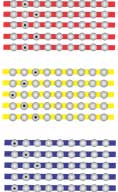14. Three-Phase Electricity
What does Phase mean?
Phase is a term used to describe one feature of Alternating Current. If wires are in phase it means that timing of the electron movement, back and forth, is the same. The electrons are 'in step' or 'in time' or 'in phase'.
To distribute AC power it is more efficient to use three circuits that are out of phase. This idea of three phase power was discovered by Nikola Tesla (1856 -1943). Much of its efficiency is because there is always voltage (electrons moving) in at least one wire.
Why not 1, 2 or 4 phases?
Three-phase power (and its multiplies) removes the need for a neutral or 'return path'. This is because joining the three phases together results in no overall current flow.
Three-phase power is an arrangement that fits in very nicely with the generator design. The 120° phase separation allows close to the optimum spacing and size of the copper conductors around the stator bore. The 3-phase generator is basically the cheapest form to make.
Multiple phase generators can be and are made for specific purposes, usually military, but they are expensive.



